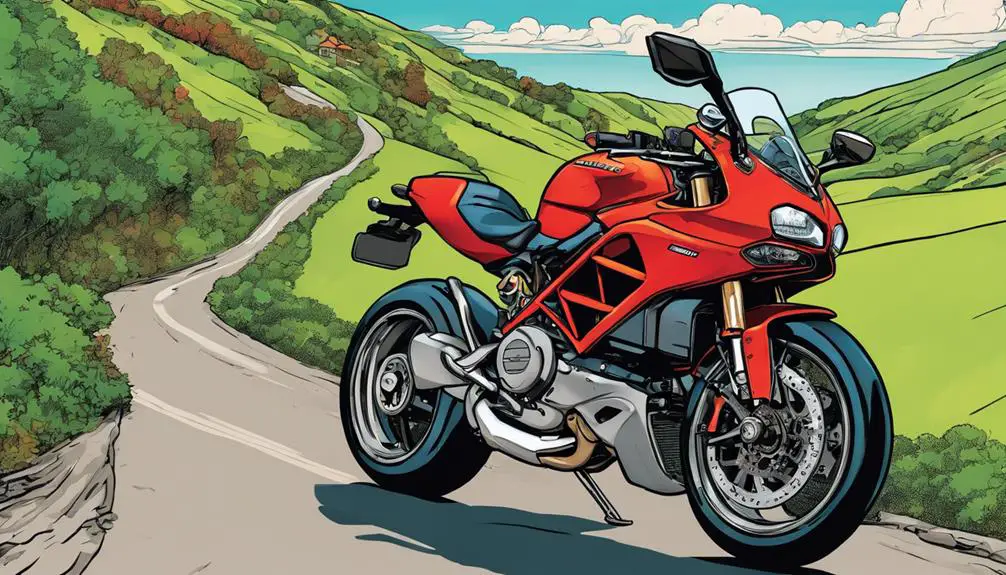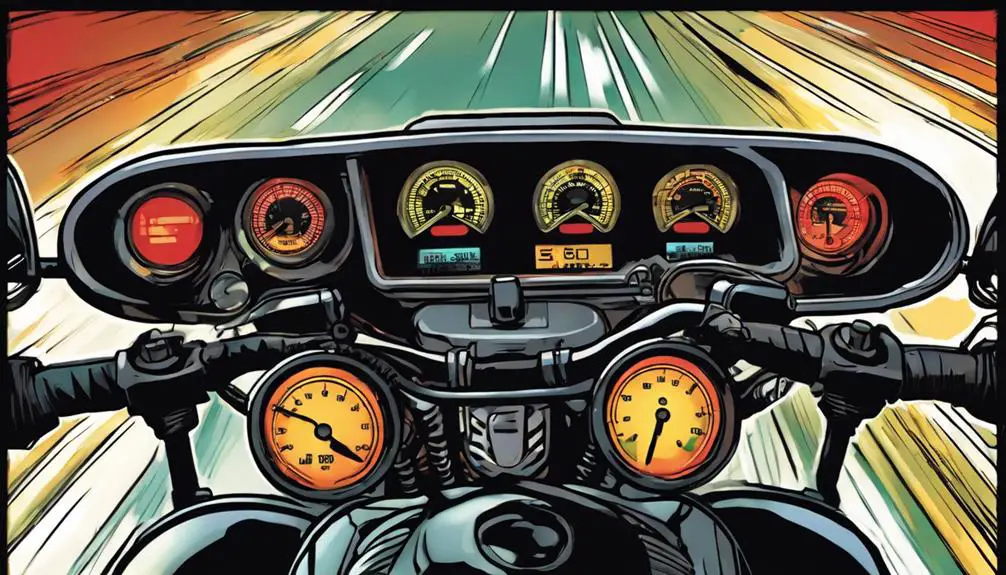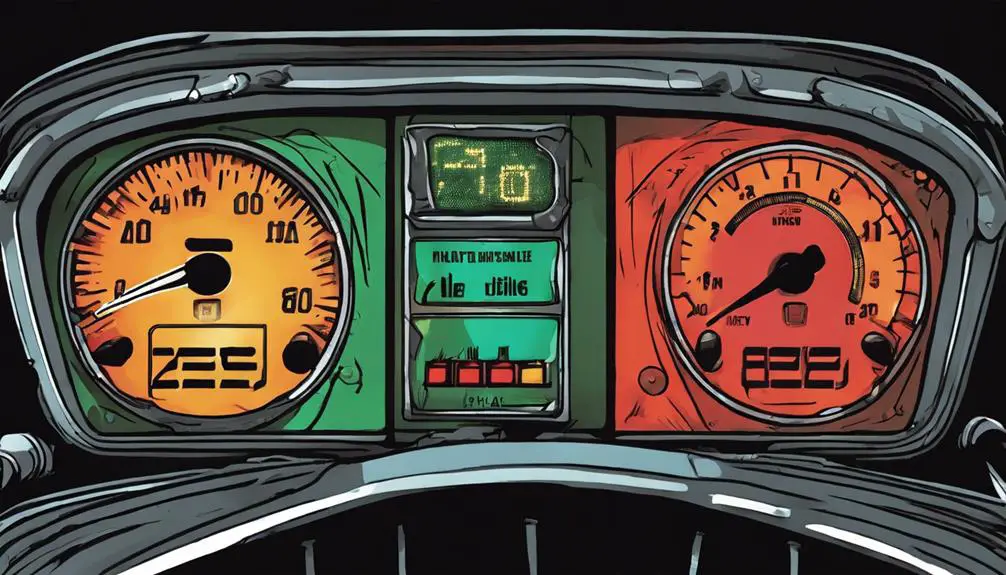Did you know that nearly 30% of motorcycle accidents are linked to mechanical failures that could've been prevented? Understanding your bike's warning lights is essential for maintaining safety and performance on the road. Each symbol conveys critical information that can help you respond effectively to potential issues. Ignoring these warnings might lead to serious consequences, but what do those lights really mean? Let's explore the key meanings behind motorcycle warning lights and how they can keep you riding smoothly.
Key Takeaways
- Warning lights communicate critical system statuses, with yellow indicating caution and red signaling severe issues requiring immediate attention.
- Common warning lights include engine, oil pressure, ABS malfunction, and brake system alerts, each indicating specific potential problems.
- Ignoring warning lights can compromise safety and motorcycle performance, making immediate action essential upon activation.
- Regularly checking fluid levels and battery health can prevent warning light activations and ensure optimal motorcycle performance.
Overview of Ducati Motorcycles

Ducati motorcycles are renowned for their performance and Italian craftsmanship, making them a favorite among riders who crave excitement on the road. When you hop on a Ducati, you're not just riding; you're embracing a lifestyle fueled by power and precision. Each model boasts a unique blend of cutting-edge technology and timeless design, ensuring that every ride feels exhilarating.
You'll find Ducati's signature L-twin engine provides an unmatched roar, giving you that adrenaline rush as you accelerate. The lightweight frames enhance agility, allowing you to carve through corners with ease, feeling the freedom of the open road. Whether you're tackling city streets or winding mountain roads, Ducati delivers an experience that's both liberating and thrilling.
The attention to detail in every component reflects a commitment to quality that resonates with passionate riders. You don't just own a Ducati; you become part of a vibrant community that celebrates the art of motorcycling.
Understanding Warning Light Symbols
Have you ever wondered what those warning light symbols on your motorcycle's dashboard really mean? Understanding these icons is fundamental to ensuring your ride remains thrilling and safe. Each symbol serves as a significant communicator, alerting you to the status of key systems on your bike.
For instance, a yellow warning light often indicates a cautionary issue, like low oil pressure or a malfunctioning sensor. You'll want to pay attention and address these warnings to keep your freedom on two wheels intact. A red light, on the other hand, signals a more severe problem, like a critical engine failure or overheating. Ignoring these can lead to costly repairs or, worse, an unsafe ride.
Familiarizing yourself with these symbols empowers you as a rider. Instead of feeling anxious when a light flickers, you'll be able to assess the situation calmly. Each ride becomes a partnership with your motorcycle, where you're in tune with its needs.
Common Ducati Warning Lights

When you're riding your Ducati, it's vital to pay attention to its warning lights.
The engine warning indicator, oil pressure alert, and ABS malfunction signal are key alerts that can affect your bike's performance and safety.
Let's break down what each of these warning lights means for your ride.
Engine Warning Indicator
The engine warning indicator lights up on your Ducati to alert you of potential issues that require immediate attention. When this light shines, it's like a call to arms; it invites you to dive deeper into the heart of your machine and guarantee it's running smoothly. Ignoring this light can lead to severe consequences, so don't brush it off.
Typically, this warning signals problems related to the engine's performance or emissions system. It could mean anything from a minor sensor issue to a more serious threat. Your freedom on the open road hinges on your bike operating at its best, and that starts with understanding this vital warning.
When you see that engine light, take a moment to check your bike's manual for specific meanings related to your model. If the light persists, it's wise to consult a mechanic who knows Ducatis inside and out.
Oil Pressure Alert
How can you ignore the oil pressure alert when it signals a critical issue with your Ducati's lubrication system? This warning light isn't just a suggestion; it's a call to action. Ignoring it can lead to severe engine damage, leaving you stranded and your ride compromised.
If that light pops on, here's what you need to do:
- Pull Over Safely: As soon as it's safe, stop your bike to assess the situation.
- Check Oil Level: Verify your oil level is adequate. Low oil can trigger the alert.
- Inspect for Leaks: Look for any visible oil leaks around the engine or on the ground.
- Consult a Mechanic: If everything seems fine but the light remains on, it's time to seek professional help.
This isn't just about keeping your bike running; it's about embracing the freedom of the road. Keeping your Ducati in prime condition guarantees you can chase horizons without worry.
Don't let an oil pressure issue rob you of that thrill—respond swiftly and responsibly!
ABS Malfunction Signal
Ignoring the ABS malfunction signal can jeopardize your safety by compromising your bike's braking performance.
When this warning light flickers on your Ducati, it means the Anti-lock Braking System isn't functioning correctly. This system is designed to prevent your wheels from locking up during hard braking, allowing you to maintain control in critical situations.
If you see this light, don't brush it off. Take it seriously. An ABS malfunction can lead to a loss of traction, especially on slippery roads, putting your freedom at risk.
You'll want to pull over and assess the situation. Check your owner's manual for guidance on resetting the system. If that doesn't work, it's time to visit a qualified mechanic.
Specific Issues Indicated by Lights
When you're riding, specific warning lights can indicate serious issues that need your attention.
For example, the engine warning light signals potential problems with your bike's performance, while the brake system indicator alerts you to braking issues.
Ignoring these lights could lead to bigger problems, so it's essential to understand what they mean.
Engine Warning Light
The engine warning light on your motorcycle signals specific issues that require your immediate attention to guarantee peak performance and safety. Ignoring this light can lead to serious problems, so it's essential to understand what it means.
Here are four potential issues you might encounter:
- Oil Pressure Drop: If the light flickers, it could indicate low oil pressure, threatening engine lubrication and longevity.
- Overheating: A steady light may suggest your engine is running too hot, which can lead to significant damage if not addressed quickly.
- Fuel System Issues: The light can also point to problems in the fuel system, like a clogged fuel filter or failing fuel pump.
- Ignition System Malfunction: If there's an issue with the ignition system, it may prevent your engine from starting or running smoothly.
When the engine warning light comes on, don't just ride it off. Pull over, assess the situation, and take action. Understanding these signals not only keeps you safe but also enhances your freedom on the open road.
Don't let engine troubles hold you back!
Brake System Indicator
Flashing or illuminated brake system indicator lights signal potential issues with your motorcycle's braking system that demand immediate attention for your safety. If you see this light, don't ignore it. It could mean your brake fluid is low, which can lead to diminished braking power. Check your fluid levels right away and top them off if necessary.
Another possibility is worn brake pads. When the pads wear down too much, the indicator light will alert you, urging you to replace them. Riding with worn pads can compromise your stopping ability, so address this issue promptly.
Additionally, a malfunction in the anti-lock braking system (ABS) might be indicated. If the ABS warning light is on, you could lose the benefits of enhanced braking control, especially in slippery conditions.
Troubleshooting Warning Light Alerts

Troubleshooting warning light alerts on your motorcycle can help guarantee a safe and smooth ride. When that light flickers on, don't just ignore it; understanding its meaning can empower you to take control of your journey. Here's a quick guide to help you tackle those alerts:
- Check the Owner's Manual: Your manual is a treasure trove of information. It'll explain what each warning light means and what action you should take.
- Inspect Fluid Levels: Low oil or coolant levels can trigger warning lights. Take a moment to check these levels and refill if necessary.
- Examine the Battery: A weak battery can cause various alerts. Test your battery's voltage and connections, ensuring everything's tight and clean.
- Look for Leaks: Fluid leaks can lead to serious issues. Inspect your bike for any signs of leaking fluids, which could indicate a problem needing immediate attention.
Preventive Measures for Common Problems
Taking proactive steps can help you avoid common motorcycle problems before they turn into serious issues. Regular maintenance is your best ally. Check your oil, fluids, and tire pressure frequently, and don't ignore any unusual sounds or vibrations. A well-lubricated chain can save you from performance headaches down the road, so make it a habit to inspect it regularly.
Keep an eye on your battery's health. Clean the terminals and verify it's charged; a dead battery can leave you stranded when you crave freedom the most. Additionally, make sure your brakes are in top shape. Worn pads or low fluid levels can compromise your safety.
Don't overlook the importance of your lights and signals. They're not just for show; they keep you visible and alert other drivers. Replace burnt-out bulbs immediately.
Frequently Asked Questions
Can Warning Lights Vary Between Different Motorcycle Brands?
Yes, warning lights can definitely vary between different motorcycle brands.
Each manufacturer designs their systems uniquely, so you might notice different symbols or colors indicating specific issues.
It's important to familiarize yourself with your bike's warning lights to guarantee you stay safe on the road.
Don't hesitate to check your owner's manual or online resources to understand what each light means.
Knowledge is power, and it keeps your ride smooth and enjoyable!
How Do I Reset the Warning Lights After Addressing Issues?
Resetting those pesky warning lights can be a straightforward step toward serenity.
First, you'll want to turn off your motorcycle and disconnect the battery for a few minutes.
Reconnect it, and then start your bike. If the lights stay lit, consult the manual for specific reset procedures.
Embrace the freedom of knowing your motorcycle's in top condition, and ride confidently without those distracting lights dimming your spirit!
What Should I Do if a Warning Light Stays On?
If a warning light stays on, don't ignore it!
You should first check your owner's manual for specific guidance.
Inspect the area related to the light—whether it's oil, brakes, or something else.
If everything seems fine, consider resetting the system.
But if the light remains, it's time to consult a professional.
Addressing these issues promptly empowers you to keep your ride safe and enjoyable!
Are Warning Lights Affected by Weather Conditions?
You might think warning lights don't care about the weather, but that's not entirely true. They can be affected by extreme temperatures and moisture, impacting their functionality.
Cold weather might cause some lights to flicker, while heavy rain can lead to temporary malfunctions.
It's crucial to stay aware and address any unusual behavior, ensuring your ride remains safe and liberating, no matter the conditions.
Trust your instincts and keep your bike in top shape!
Is It Safe to Ride With Warning Lights Illuminated?
Riding with warning lights illuminated isn't safe, and you shouldn't ignore them. Those lights signal potential issues that could affect your bike's performance or safety.
If you see them, it's best to pull over and assess the situation. Ignoring these warnings could lead to accidents or costly repairs.
Embrace freedom on the road by ensuring your ride is in top shape—don't take unnecessary risks when it comes to your safety.
Conclusion
In the world of Ducati motorcycles, understanding warning lights can mean the difference between a thrilling ride and a costly breakdown.
While a yellow light might seem like a minor hiccup, a red light demands your immediate attention.
By familiarizing yourself with these symbols, you not only enhance your safety but also elevate your riding experience.
Don't ignore these essential alerts; embrace them as your bike's way of communicating, ensuring you stay in the fast lane without a hitch.